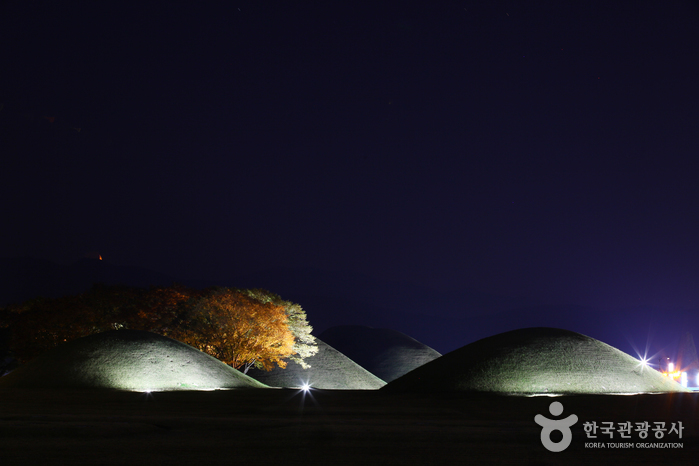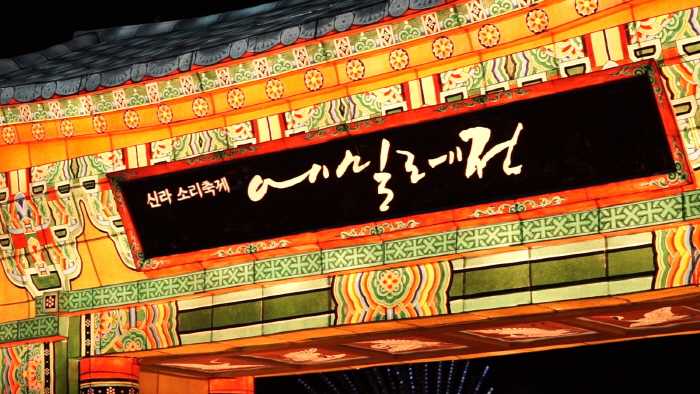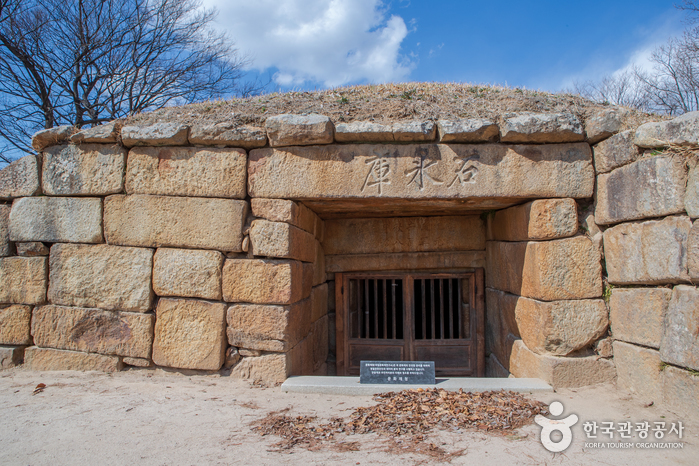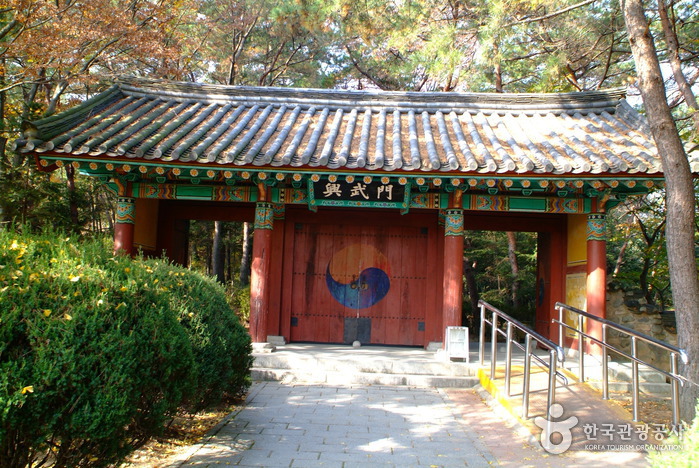Gyeongju Royal Tomb of King Naemul (경주 내물왕릉)
1.2Km 2020-04-04
Gyo-dong, Gyeongju-si, Gyeongsangbuk-do
+82-54-779-6100
King Naemul was the 17th monarch of the Silla Kingdom (in power from 356 to 402) and became the second king of the Kim family name. King Naemul was known as the first king to initiate the king title of ‘Maripgan’ and was known for spreading cultural advancements from China to the Korean people. When the allied forces of Baekje and Japan attacked, he asked Gwanggaeto the Great of Goguryeo for help and led the people to victory, contributing to the increased strength of the Silla Kingdom. After his rule, the throne was exclusively ceded to members of the Kim family clan.
The royal tomb of King Naemul is a large mound (22 m in diameter and 5.3 m in x_height) that sits on the northern hill of the Confucian school of Gyeongju. The edge of a natural stone is exposed around the bottom of the mound, pointing to the fact that the inner chamber tomb was made of stone. In the historical document Samguk Sagi (History of the Three Kingdoms), no records are found about the tomb, but the Samguk Yusa (Memorabilia of the Three Kingdoms) describes the king’s tomb as being located in the southwest of Cheomseongdae, which is consistent with the tomb’s location.
Gyeongju Gyerim Forest (경주 계림)
1.2Km 2020-07-06
Gyo-dong, Gyeongju-si, Gyeongsangbuk-do
+82-54-779-8743
Gyerim Forest is located between the Cheomseongdae Observatory and Wolseong Fortress. The forest is thickly populated by ancient zelkova and willow trees rooted on gently sloping hills and along the small stream in the northwest part of the woods. According to legend, the forest is closely associated with myths surrounding the birth of Alji, the founder of the Gyeongju Kim clan. As such, it is designated national Historic Site No. 19.
Legend has it that King Talhae heard a rooster crying from deep inside the Sirim Woods. Chancellor Hogong was sent to investigate. Upon arriving, he found a rooster crying underneath a tree on which hung a golden box. Hogong immediately reported his find to the king, who instructed him to bring the golden box into the palace. The king opened the box and found a small child inside, Kim Alji. The forest, which had previously been called ‘Sirim’ or ‘Gurim’, became known as ‘Gyerim’, ('gye’ meaning rooster). The name Gyerim was also used to refer to the Silla kingdom.
Alji was adopted as the king’s son, but because the crown was passed on to King Pasa of the Park family, he never ascended the throne. The Kim clan later became the royal bloodline with the coronation of King Naemul some years later.
The memorial stone recording the birth of Kim Alji was erected in the third year of King Sunjo's rule in the Joseon dynasty. Located close to the royal fortress of Silla, the forest is still deeply revered as the mystical birthplace of the first ancestor of the royal Kim clan of Silla. Yellow canola blossoms along the path connecting Daereungwon with Gyerim and Banwolseong only add to the magical ambiance of the forest.
Hanok Stay Joadang [Korea Quality] 한옥스테이 조아당[한국관광 품질인증]
1.3Km 2025-03-24
11 Wonhyo-ro 213beon-gil, Gyeongju-si, Gyeongsangbuk-do
+82-10-6520-5074
Joadang is a private hanok stay on Wonhyoro-gil, Gyeongju, Gyeongsangbuk-do. The inside of this traditional hanok is finished with cypresswood, and guests can catch the scent of cypress and feel refreshed. There are two guestrooms, both with a queen-size bed, and one with its own bathroom. The location is great for walking and for seeing the sights of Gyeongju.
Gyeongjuhyanggyo Local Confucian School (경주향교)
1.3Km 2025-06-12
27-20 Gyochonan-gil, Gyeongju-si, Gyeongsangbuk-do
Gyeongjuhyanggyo Local Confucian School is located near Gyochon Hanok Village in Gyeongju. The surrounding areas, Gyochon, Gyori, and Gyodong, derive their names because of this school. Although the exact date of its original construction is unknown, Gyeongju Hyanggyo was renovated during the reign of King Seongjong of the Joseon Dynasty, modeled after Seoul’s Seonggyungwan National Academy. The buildings follow the typical Confucian layout of “hall in the front, shrine in the back.” While seowon were private academies, hyanggyo were public institutions. Although it no longer serves the educational purpose, every spring and autumn it hosts traditional Confucian rituals. It also offers cultural programs such as tea ceremonies, rice-cake pounding, and archery. From April to October it hosts traditional Korean-style demonstration weddings, where visitors can participate in the ceremonies for free.
Gyeongju Gyochon Traditional Village (경주 교촌마을)
1.3Km 2025-05-21
39-2 Gyochon-gil, Gyeongju-si, Gyeongsangbuk-do
At Gyeongju Gyochon Village, visitors can see the House of the Gyeongju Choi Clan (Important Folklore Material No. 27) and try some Gyeongju Gyodong Beopju Liquor (Important Intangible Cultural Asset No. 86-3). The village centers around the Gyeongju Choi Clan, a family known to have maintained their wealth for over 12 generations, producing many important people. Visitors can learn about the lifestyle and spending habits that enabled the family to do this. The village is also home to the site of Yoseokgung, the house of Silla Princess Yoseok. Nearby attractions include Gyerim Forest, Naemulwangneung Royal Tomb, and Gyeongjuhyanggyo Local Confucian School.
Yosukgung 1779 (요석궁1779)
1.4Km 2025-09-02
19-4 Gyochonan-gil, Gyeongju-si, Gyeongsangbuk-do
Named after Silla King Muyeol's daughter Princess Yoseok, Yosukgung 1779 is a fine dining restaurant that serves traditional Korean food. The resturant is run by the Choi family, who settled on the site of Princess Yoseok's house during the Joseon dynasty, and has passed on the restaurant and family recipes through 12 generations. All the foods served are made with organic ingredients, for a healthy taste that cannot be found anywhere else.
Silla Sori Festival - Emille (신라소리축제 에밀레전)
1.5Km 2021-01-08
274, Gyo-dong, Gyeongju-si, Gyeongsangbuk-do
• 1330 Travel Hotline: +82-2-1330 (Korean, English, Japanese, Chinese) • For more info: +82-53-427-5114
Silla Sori Festival mainly focuses on the King Seongdeok Divine Bell (Emille Bell), established during the Unified Silla period, and takes place in Gyeongju, embracing its thousand-year-old heritage. The festival has been held to acknowledge the value and legacy of this traditional Korean bell dating back to the Silla period.
Seokbinggo (Stone Ice Storage) (경주 석빙고)
1.5Km 2020-04-06
Inwang-dong, Gyeongju-si, Gyeongsangbuk-do
+82-54-779-6100
Seokbinggo means a freezer made of rocks. It is an ancient refrigerator only in Korea. It is located in Gyeongju, the ancient capital of the Silla Era (BC57-AD935). The appearance of this wonderful vestige is humble and simple. But you will not be disappointed at the entrance of the freezer. You can feel the cold from inside the structure. Half of Seokbinggo is underground while the other half is above ground, signifying the scientific propensity of Korea. The floor, walls, and ceiling are made of granite and have an airway. The walls are covered with limestone to keep off moisture and water. The floor is slanted to allow melted ice to funnel out. Frozen ice was popular for the upper class. From historical annals, it is assumed that Seokbinggo was made at least 1,500 years ago. Seokbbingo has been designated as National Treasure No. 66.
Gyeongju Tomb of Kim Yu-sin (경주 김유신묘)
1.6Km 2022-08-12
44-7, Chunghyo 2-gil, Gyeongju-si, Gyeongsangbuk-do
+82-54-749-6713
The tomb of General Kim Yu-sin (595-673) is located near the Gyeongju Express Bus Terminal at the end of a scenic lane, popular in spring for its walls of yellow forsythia and pink cherry blossom trees in bloom. The tomb itself is located in a scenic area thick with pine trees, on the eastern side of Songhwasan Mountain. The tomb of General Kim Yu-sin is a large tomb measuring roughly 30 meters in diameter, circled by a stone fence with 24 guard posts. The tomb base wall features relief carvings of the 12 Oriental zodiac gods standing guard over the tomb, brandishing weapons. The carvings are unique in that while their bodies face outwards, the heads are all turned to the right. The elaborately decorated tomb is second in grandeur only to those of royalty.


![Hanok Stay Joadang [Korea Quality] 한옥스테이 조아당[한국관광 품질인증]](http://tong.visitkorea.or.kr/cms/resource/08/3009408_image2_1.jpg)




 English
English
 한국어
한국어 日本語
日本語 中文(简体)
中文(简体) Deutsch
Deutsch Français
Français Español
Español Русский
Русский